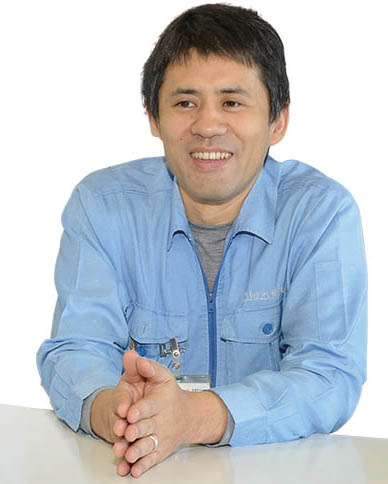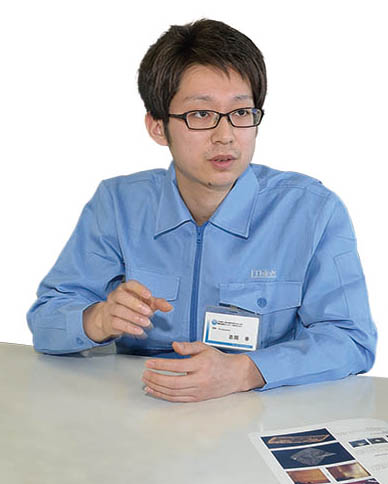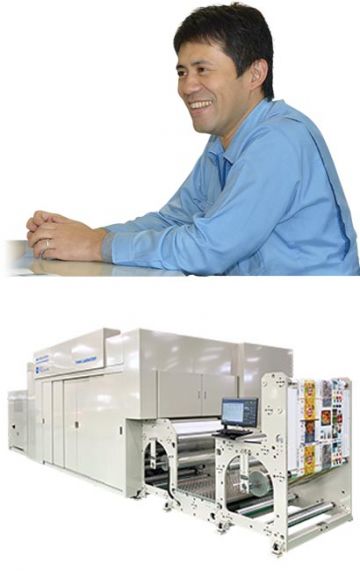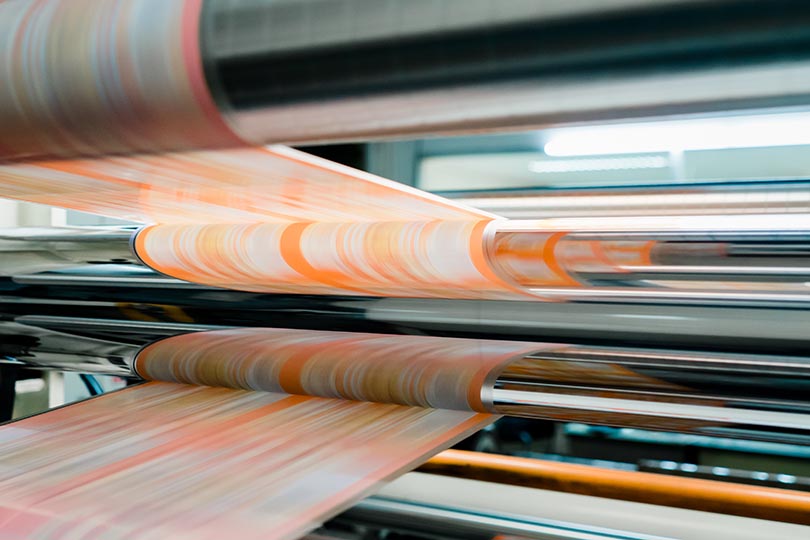 Think Laboratory’s Development Department Director, Shintaro Sugawara |  Think Laboratory Development Department team member, Takashi Yoshioka |
Think Laboratory, located in Kashiwa City, Japan manufactures fully automated gravure cylinder making systems, which are mainly used for printing packages for food and other commercial products. Its customers include gravure cylinder suppliers and printing companies.

Illustration of gravure cylinders on a rack prior the laser engraving process
Think Laboratory’s gravure-cylinder making systems use maskless laser-based photolithography to produce printing cylinders. A 3200 × 12800 dpi high-resolution laser beam is focused on a 2 μm × 8 μm area of the cylinder to form tiny honeycomb-shaped cells that will collect the ink to produce the printed image. On average, CMYK (cyan, magenta, yellow, black) cells are 12–15 μm deep and white cells are 15–16 μm deep, and the smallest cell is around 100 μm × 100 μm. The small dimensions of these cells mean that the label production process is economical on solvent and ink.
The High Speed and Accuracy of Today’s Rotogravure Process
In the past, the engraving process was time-consuming as it was done manually. Think Laboratory’s fully automated gravure-cylinder making systems take about an hour to produce one cylinder. A completed cylinder is loaded into a gravure printing machine and then used to produce runs of labeling or packaging that is loaded onto rolls. The printing speeds reach 200–400 meters per min (656–1312 fpm). Even during such high-speed printing, Think Laboratory cylinders must maintain good density and high color stability.
Variations in the cylinder engraving specifications of only 1% can cause smudging of the text or color errors in the resulting labels. If a customer reports a defect in samples printed with Think Laboratory produced cylinders, the company collects the gravure cylinder and a printing sample to investigate the cause of the defect. The accuracy required is 1 μm or higher.
What Motivated the Switch to the DSX1000 Digital Microscope?
When Olympus’ DSX1000 digital microscope was launched in June 2019, Think Laboratory chose to integrate one into its quality-control (QC) process. The company already used other Olympus inspection products (including XRF and borescope instruments) and Mr. Tatsuo Shigeta, President of Think Laboratory and a long-time Olympus camera user, has in-depth knowledge of optical technologies.
Think Laboratory was also convinced because one of its critical requirements, a minimum accuracy of 1 μm could be met by the DSX1000 digital microscope. It also offers several other functionalities that would potentially improve the efficiency of its quality control process.

After having used the DSX1000 microscope for nearly a year, Shintaro Sugawara, Development Department Leader, and Takashi Yoshioka, a Development Department team member and principal user, were asked to share their opinions on its operability and performance.

Takashi Yoshioka standing at the Think Laboratory workstation for the DSX1000 digital microscope, a preliminary diagnostic tool in the quality control process
Empowering Think Laboratory to Meet Its Customers’ High Standards
Users of Think Laboratory’s gravure cylinders, such as cosmetic and automotive companies, often require a level of quality that portrays luxury. “Demand for high-quality printing has been increasing recently, so our quest for higher accuracy in analysis and our expectation of higher efficiency have prompted the installation of the DSX1000 microscope,” says Takashi Yoshioka.
“It’s no exaggeration to say that quality management is one of our lifelines,” adds Mr. Sugawara, “the company continually strives to further improve our accuracy to meet more advanced printing needs.”
The DSX1000 microscope is used as the first-line analysis tool when a customer reports a flaw. Offering six observation methods—brightfield (bf), oblique, darkfield (df), mix, polarization, and differential interference—the DSX1000 microscope’s ease of operation is a real advantage. Mr. Yoshioka says he appreciates the simple one-button click to switch between the six observation methods without losing sight of the sample. He also underscored the usefulness of the multiple preview function, which enables him to compare images acquired with the different methods on screen all at once and then select the best one.
“The method that works best for each sample can be selected from the different images displayed. This function is quite useful. With conventional microscopes, observation conditions must be adjusted precisely each time to capture two types of images: an image with emphasis placed on its visual appearance to use on reports and another that is suitable for conducting a failure analysis. The DSX1000 microscope has eliminated the need for this adjustment and saved a huge amount of time spent on tasks, from running analyses to reporting,” he says.
Practical Features to Ease Lab Work for Technicians
Another feature that Mr. Yoshioka finds practical for his sample-analysis tasks is the lens switching mechanism. “It's convenient to switch quickly when changing samples and you want to change to a different magnification lens. Sometimes it’s easier to find the cause of a defect by looking at the whole sample with a lower magnification lens, so it is a useful function to have when observing and analyzing any sample. With conventional digital microscopes, lens replacement is cumbersome and time consuming because the lens needs to be screwed into a hole, but the sliding mechanism of the DSX1000 microscope has made lens replacement easy, and I don’t have to worry about dropping the lens.”
Both Mr. Sugawara and Mr. Yoshioka expressed their satisfaction with the high-quality and extensive lineup of up to 17 objective lenses offered by Olympus, in terms of cost performance.

Each image file acquired with the DSX1000 microscope contains information about the observation conditions—such as the magnification, illumination method, and camera settings. These conditions can be retrieved by simply clicking the image.
This saves time for Mr. Yoshioka and his colleagues, particularly when there are different operators using the microscope. They can avoid searching for the optimal observation conditions each time, enabling more efficient and effective analysis to be performed. Digitalization of Label Printing Is around the CornerTo provide flexible solutions that meet the needs of its customers, Think Laboratory has developed an inkjet printing system to work in tandem with gravure-cylinder systems. Fortunately, the advantages provided by the DSX1000 microscope can be applied to the quality control of all its sample types, present and potential. Mr. Sugawara concluded by saying, “The digitalization of gravure printing is around the corner. We will accelerate our efforts to promote inkjet printers and laser printing. Since demand for higher accuracy is increasing in the market, we will continue to strive for higher accuracy control to meet this demand.” This continuing demand for higher quality printing will ensure that the DSX1000 digital microscope remains an important tool for Think Laboratory. |  Think Laboratory’s FXIJ inkjet printing system |
Related Content
Modern Digital Microscopes: Jack of All Trades, Master of All
5 Advantages of the DSX1000 Digital Microscope
Get In Touch

